Project: Cloud-Based System Design and Implementation for AusEd Inc.
VerifiedAdded on 2021/06/17
|11
|2562
|27
Project
AI Summary
This project proposes a cloud-based system design for AusEd Inc., an organization providing distance learning. The project addresses the need for a scalable, reliable, and secure system to accommodate a growing number of students, including those in remote areas. The solution utilizes a private cloud architecture, emphasizing security and cost-effectiveness. The system design incorporates a layered network infrastructure, including core, distribution, and access layers, using technologies like Cisco and Juniper. The implementation involves a Moodle-based Learning Management System and various open-source and proprietary solutions. The project also covers cost analysis, e-waste reduction strategies, and the use of cloud services like monitoring and backup. The design aims to enhance network management through protocols like Ether Channel and OpenFlow, and it also highlights the importance of user authentication, access control, and content hosting. The project's conclusion highlights the benefits of the proposed private cloud architecture in meeting the organization's needs.

V [Company address]
[DOCUMENT TITLE]
[DOCUMENT TITLE]
Paraphrase This Document
Need a fresh take? Get an instant paraphrase of this document with our AI Paraphraser
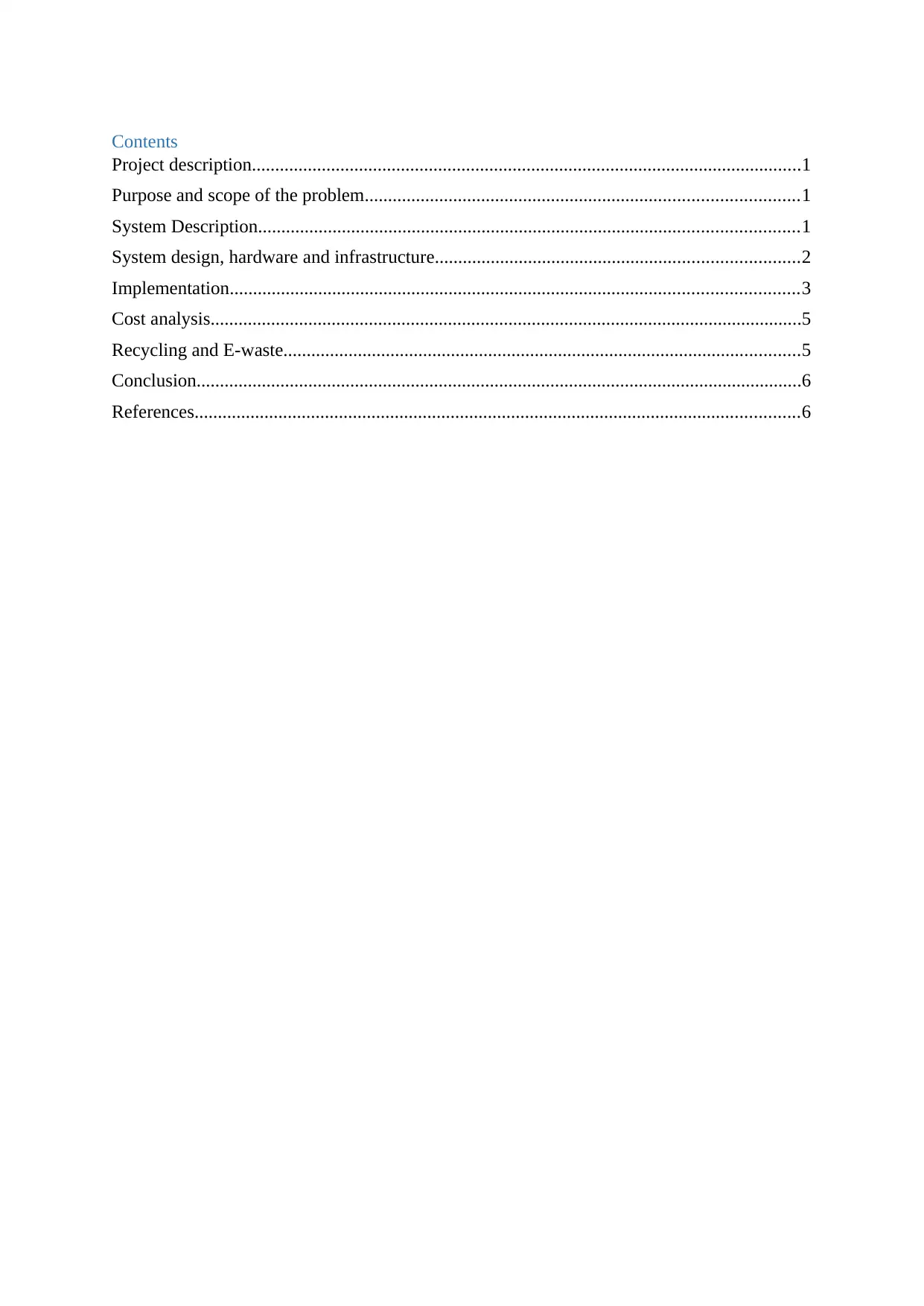
Contents
Project description......................................................................................................................1
Purpose and scope of the problem.............................................................................................1
System Description....................................................................................................................1
System design, hardware and infrastructure..............................................................................2
Implementation..........................................................................................................................3
Cost analysis...............................................................................................................................5
Recycling and E-waste...............................................................................................................5
Conclusion..................................................................................................................................6
References..................................................................................................................................6
Project description......................................................................................................................1
Purpose and scope of the problem.............................................................................................1
System Description....................................................................................................................1
System design, hardware and infrastructure..............................................................................2
Implementation..........................................................................................................................3
Cost analysis...............................................................................................................................5
Recycling and E-waste...............................................................................................................5
Conclusion..................................................................................................................................6
References..................................................................................................................................6
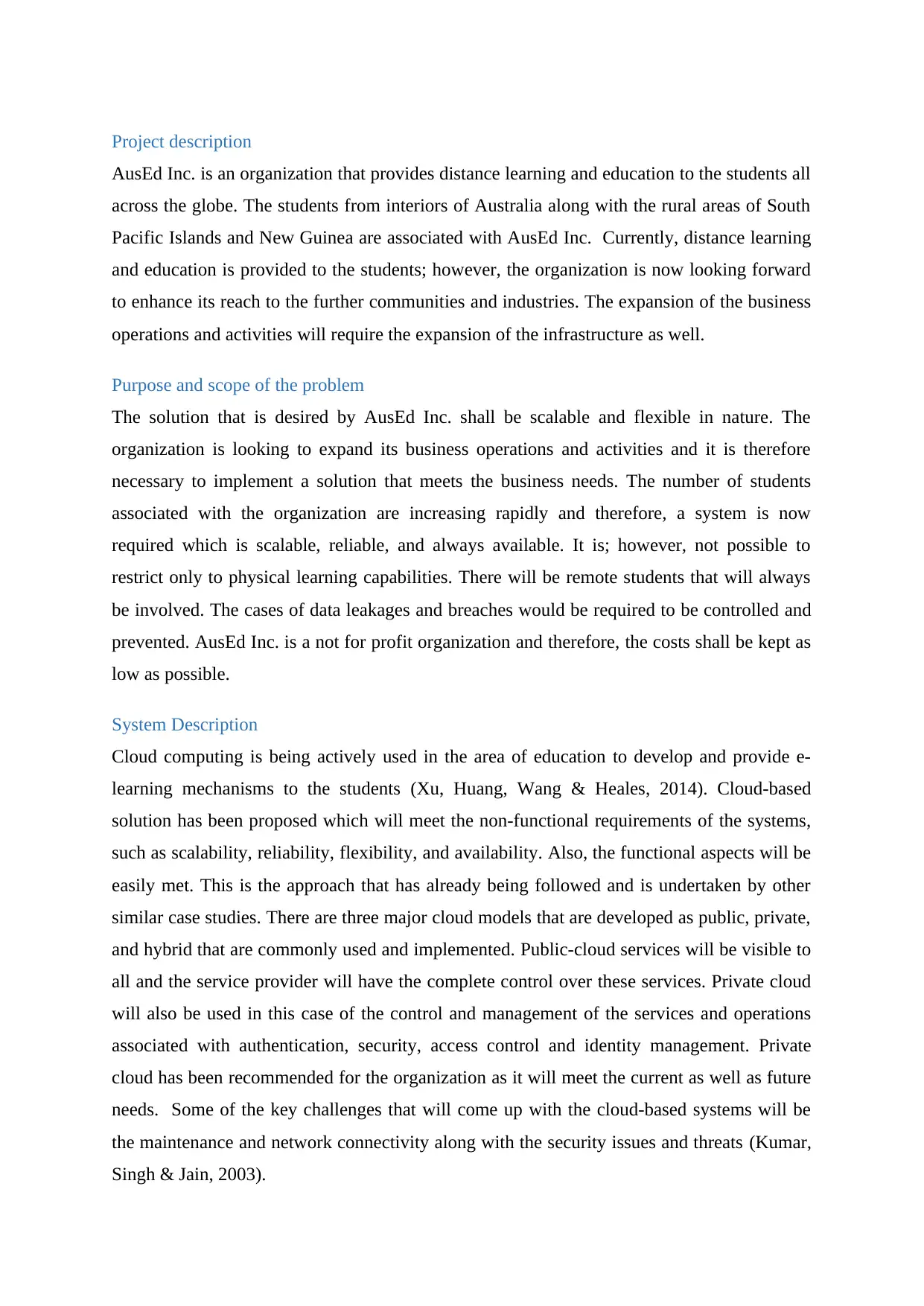
Project description
AusEd Inc. is an organization that provides distance learning and education to the students all
across the globe. The students from interiors of Australia along with the rural areas of South
Pacific Islands and New Guinea are associated with AusEd Inc. Currently, distance learning
and education is provided to the students; however, the organization is now looking forward
to enhance its reach to the further communities and industries. The expansion of the business
operations and activities will require the expansion of the infrastructure as well.
Purpose and scope of the problem
The solution that is desired by AusEd Inc. shall be scalable and flexible in nature. The
organization is looking to expand its business operations and activities and it is therefore
necessary to implement a solution that meets the business needs. The number of students
associated with the organization are increasing rapidly and therefore, a system is now
required which is scalable, reliable, and always available. It is; however, not possible to
restrict only to physical learning capabilities. There will be remote students that will always
be involved. The cases of data leakages and breaches would be required to be controlled and
prevented. AusEd Inc. is a not for profit organization and therefore, the costs shall be kept as
low as possible.
System Description
Cloud computing is being actively used in the area of education to develop and provide e-
learning mechanisms to the students (Xu, Huang, Wang & Heales, 2014). Cloud-based
solution has been proposed which will meet the non-functional requirements of the systems,
such as scalability, reliability, flexibility, and availability. Also, the functional aspects will be
easily met. This is the approach that has already being followed and is undertaken by other
similar case studies. There are three major cloud models that are developed as public, private,
and hybrid that are commonly used and implemented. Public-cloud services will be visible to
all and the service provider will have the complete control over these services. Private cloud
will also be used in this case of the control and management of the services and operations
associated with authentication, security, access control and identity management. Private
cloud has been recommended for the organization as it will meet the current as well as future
needs. Some of the key challenges that will come up with the cloud-based systems will be
the maintenance and network connectivity along with the security issues and threats (Kumar,
Singh & Jain, 2003).
AusEd Inc. is an organization that provides distance learning and education to the students all
across the globe. The students from interiors of Australia along with the rural areas of South
Pacific Islands and New Guinea are associated with AusEd Inc. Currently, distance learning
and education is provided to the students; however, the organization is now looking forward
to enhance its reach to the further communities and industries. The expansion of the business
operations and activities will require the expansion of the infrastructure as well.
Purpose and scope of the problem
The solution that is desired by AusEd Inc. shall be scalable and flexible in nature. The
organization is looking to expand its business operations and activities and it is therefore
necessary to implement a solution that meets the business needs. The number of students
associated with the organization are increasing rapidly and therefore, a system is now
required which is scalable, reliable, and always available. It is; however, not possible to
restrict only to physical learning capabilities. There will be remote students that will always
be involved. The cases of data leakages and breaches would be required to be controlled and
prevented. AusEd Inc. is a not for profit organization and therefore, the costs shall be kept as
low as possible.
System Description
Cloud computing is being actively used in the area of education to develop and provide e-
learning mechanisms to the students (Xu, Huang, Wang & Heales, 2014). Cloud-based
solution has been proposed which will meet the non-functional requirements of the systems,
such as scalability, reliability, flexibility, and availability. Also, the functional aspects will be
easily met. This is the approach that has already being followed and is undertaken by other
similar case studies. There are three major cloud models that are developed as public, private,
and hybrid that are commonly used and implemented. Public-cloud services will be visible to
all and the service provider will have the complete control over these services. Private cloud
will also be used in this case of the control and management of the services and operations
associated with authentication, security, access control and identity management. Private
cloud has been recommended for the organization as it will meet the current as well as future
needs. Some of the key challenges that will come up with the cloud-based systems will be
the maintenance and network connectivity along with the security issues and threats (Kumar,
Singh & Jain, 2003).
⊘ This is a preview!⊘
Do you want full access?
Subscribe today to unlock all pages.

Trusted by 1+ million students worldwide
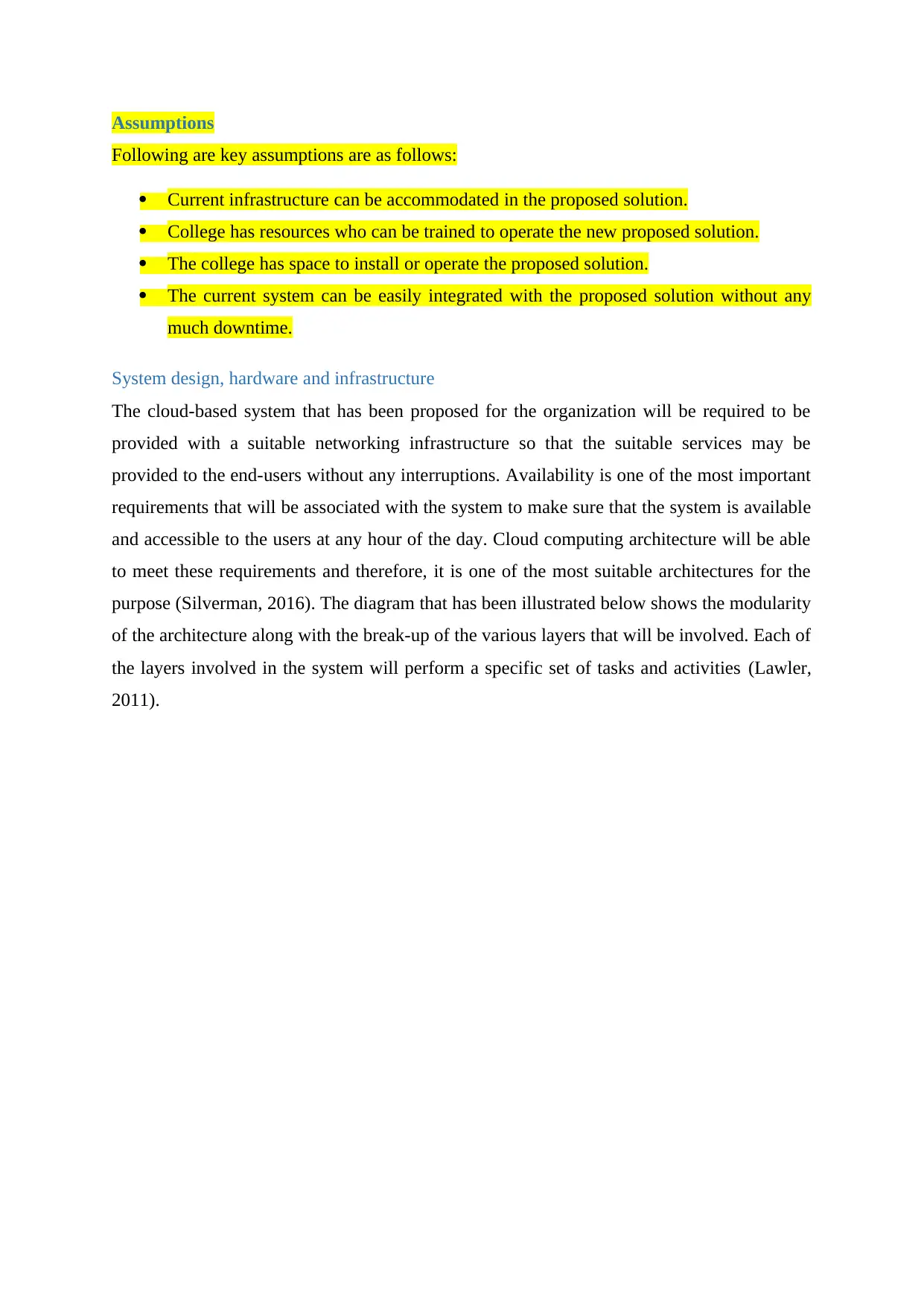
Assumptions
Following are key assumptions are as follows:
Current infrastructure can be accommodated in the proposed solution.
College has resources who can be trained to operate the new proposed solution.
The college has space to install or operate the proposed solution.
The current system can be easily integrated with the proposed solution without any
much downtime.
System design, hardware and infrastructure
The cloud-based system that has been proposed for the organization will be required to be
provided with a suitable networking infrastructure so that the suitable services may be
provided to the end-users without any interruptions. Availability is one of the most important
requirements that will be associated with the system to make sure that the system is available
and accessible to the users at any hour of the day. Cloud computing architecture will be able
to meet these requirements and therefore, it is one of the most suitable architectures for the
purpose (Silverman, 2016). The diagram that has been illustrated below shows the modularity
of the architecture along with the break-up of the various layers that will be involved. Each of
the layers involved in the system will perform a specific set of tasks and activities (Lawler,
2011).
Following are key assumptions are as follows:
Current infrastructure can be accommodated in the proposed solution.
College has resources who can be trained to operate the new proposed solution.
The college has space to install or operate the proposed solution.
The current system can be easily integrated with the proposed solution without any
much downtime.
System design, hardware and infrastructure
The cloud-based system that has been proposed for the organization will be required to be
provided with a suitable networking infrastructure so that the suitable services may be
provided to the end-users without any interruptions. Availability is one of the most important
requirements that will be associated with the system to make sure that the system is available
and accessible to the users at any hour of the day. Cloud computing architecture will be able
to meet these requirements and therefore, it is one of the most suitable architectures for the
purpose (Silverman, 2016). The diagram that has been illustrated below shows the modularity
of the architecture along with the break-up of the various layers that will be involved. Each of
the layers involved in the system will perform a specific set of tasks and activities (Lawler,
2011).
Paraphrase This Document
Need a fresh take? Get an instant paraphrase of this document with our AI Paraphraser
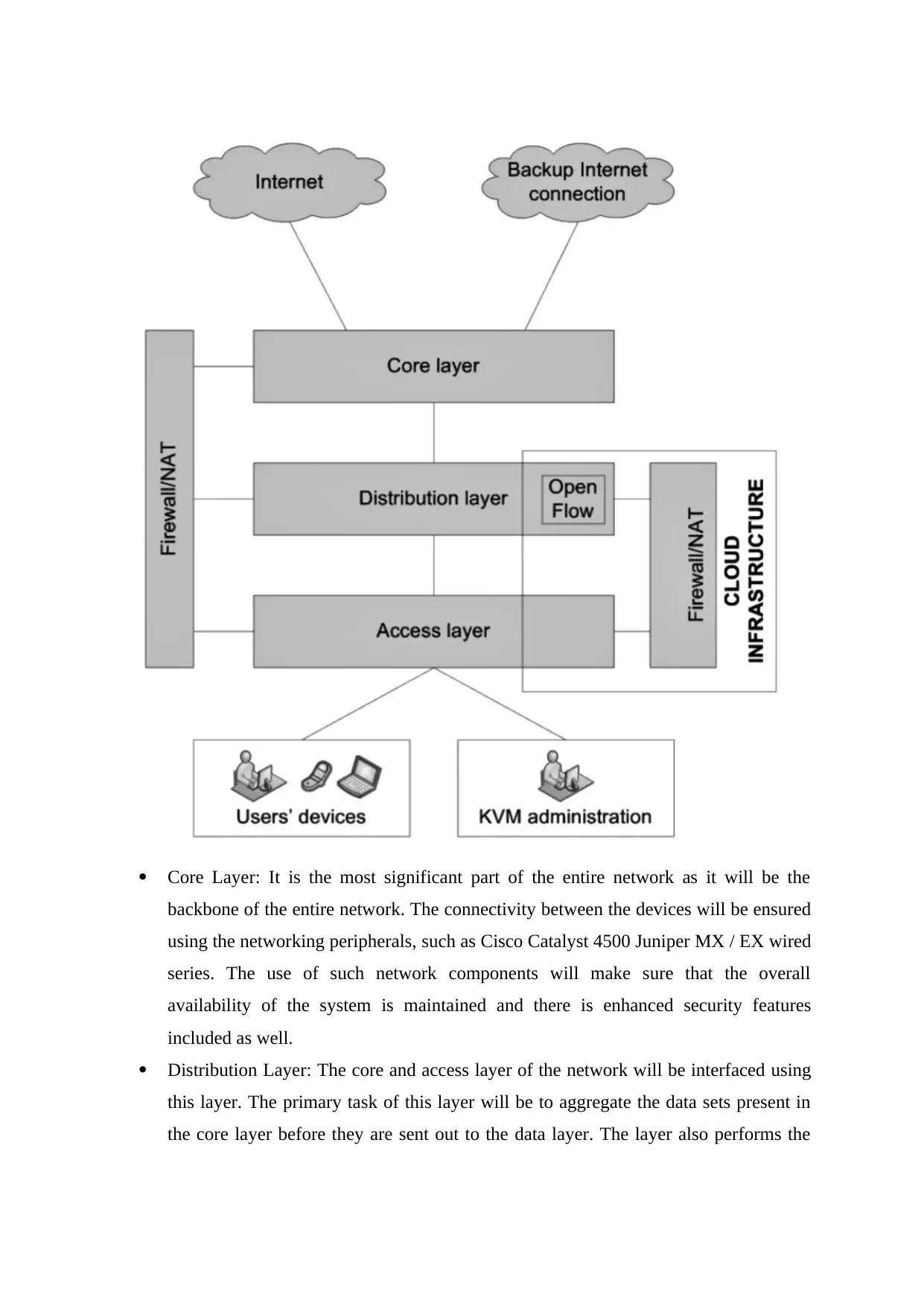
Core Layer: It is the most significant part of the entire network as it will be the
backbone of the entire network. The connectivity between the devices will be ensured
using the networking peripherals, such as Cisco Catalyst 4500 Juniper MX / EX wired
series. The use of such network components will make sure that the overall
availability of the system is maintained and there is enhanced security features
included as well.
Distribution Layer: The core and access layer of the network will be interfaced using
this layer. The primary task of this layer will be to aggregate the data sets present in
the core layer before they are sent out to the data layer. The layer also performs the
backbone of the entire network. The connectivity between the devices will be ensured
using the networking peripherals, such as Cisco Catalyst 4500 Juniper MX / EX wired
series. The use of such network components will make sure that the overall
availability of the system is maintained and there is enhanced security features
included as well.
Distribution Layer: The core and access layer of the network will be interfaced using
this layer. The primary task of this layer will be to aggregate the data sets present in
the core layer before they are sent out to the data layer. The layer also performs the
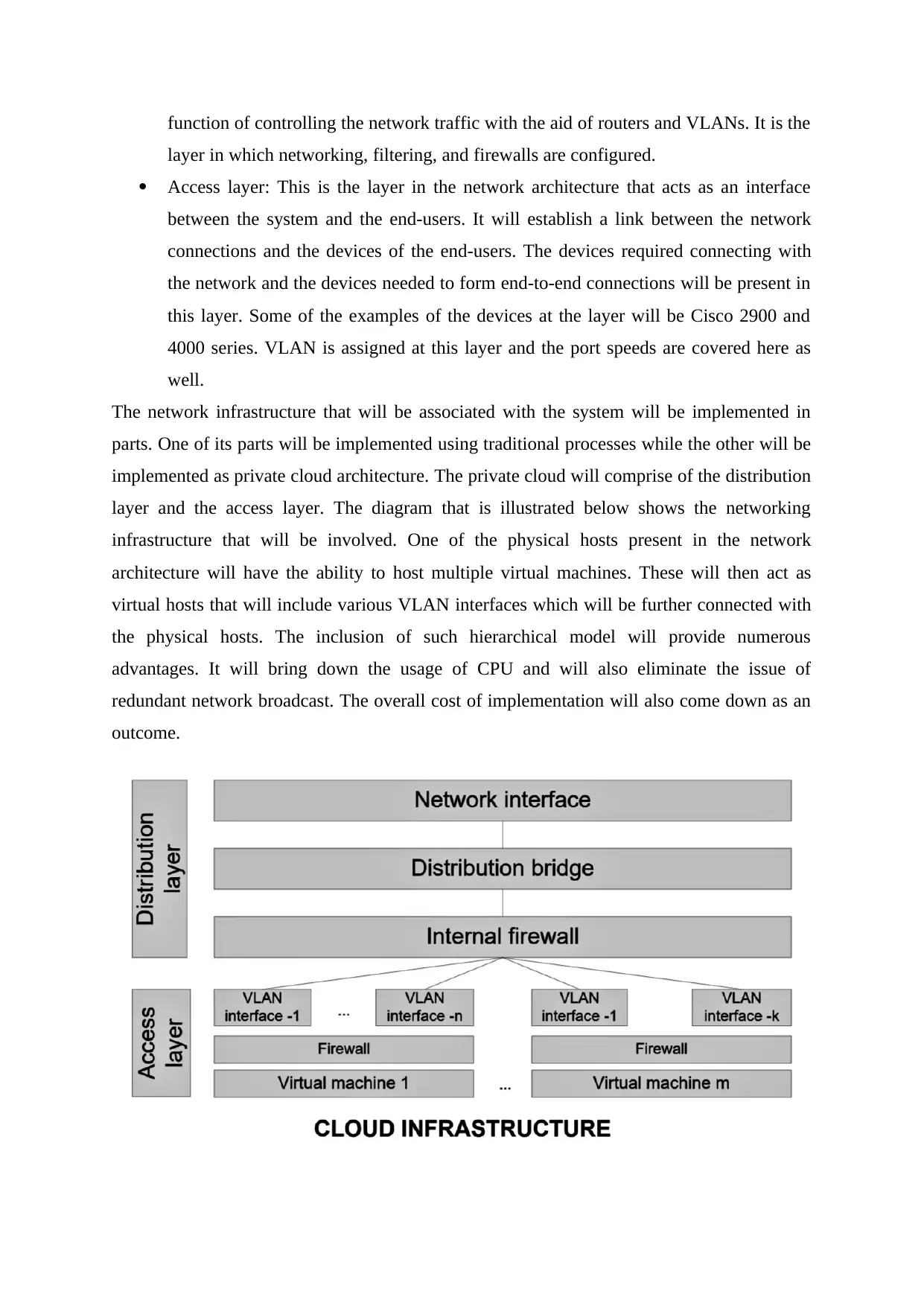
function of controlling the network traffic with the aid of routers and VLANs. It is the
layer in which networking, filtering, and firewalls are configured.
Access layer: This is the layer in the network architecture that acts as an interface
between the system and the end-users. It will establish a link between the network
connections and the devices of the end-users. The devices required connecting with
the network and the devices needed to form end-to-end connections will be present in
this layer. Some of the examples of the devices at the layer will be Cisco 2900 and
4000 series. VLAN is assigned at this layer and the port speeds are covered here as
well.
The network infrastructure that will be associated with the system will be implemented in
parts. One of its parts will be implemented using traditional processes while the other will be
implemented as private cloud architecture. The private cloud will comprise of the distribution
layer and the access layer. The diagram that is illustrated below shows the networking
infrastructure that will be involved. One of the physical hosts present in the network
architecture will have the ability to host multiple virtual machines. These will then act as
virtual hosts that will include various VLAN interfaces which will be further connected with
the physical hosts. The inclusion of such hierarchical model will provide numerous
advantages. It will bring down the usage of CPU and will also eliminate the issue of
redundant network broadcast. The overall cost of implementation will also come down as an
outcome.
layer in which networking, filtering, and firewalls are configured.
Access layer: This is the layer in the network architecture that acts as an interface
between the system and the end-users. It will establish a link between the network
connections and the devices of the end-users. The devices required connecting with
the network and the devices needed to form end-to-end connections will be present in
this layer. Some of the examples of the devices at the layer will be Cisco 2900 and
4000 series. VLAN is assigned at this layer and the port speeds are covered here as
well.
The network infrastructure that will be associated with the system will be implemented in
parts. One of its parts will be implemented using traditional processes while the other will be
implemented as private cloud architecture. The private cloud will comprise of the distribution
layer and the access layer. The diagram that is illustrated below shows the networking
infrastructure that will be involved. One of the physical hosts present in the network
architecture will have the ability to host multiple virtual machines. These will then act as
virtual hosts that will include various VLAN interfaces which will be further connected with
the physical hosts. The inclusion of such hierarchical model will provide numerous
advantages. It will bring down the usage of CPU and will also eliminate the issue of
redundant network broadcast. The overall cost of implementation will also come down as an
outcome.
⊘ This is a preview!⊘
Do you want full access?
Subscribe today to unlock all pages.

Trusted by 1+ million students worldwide
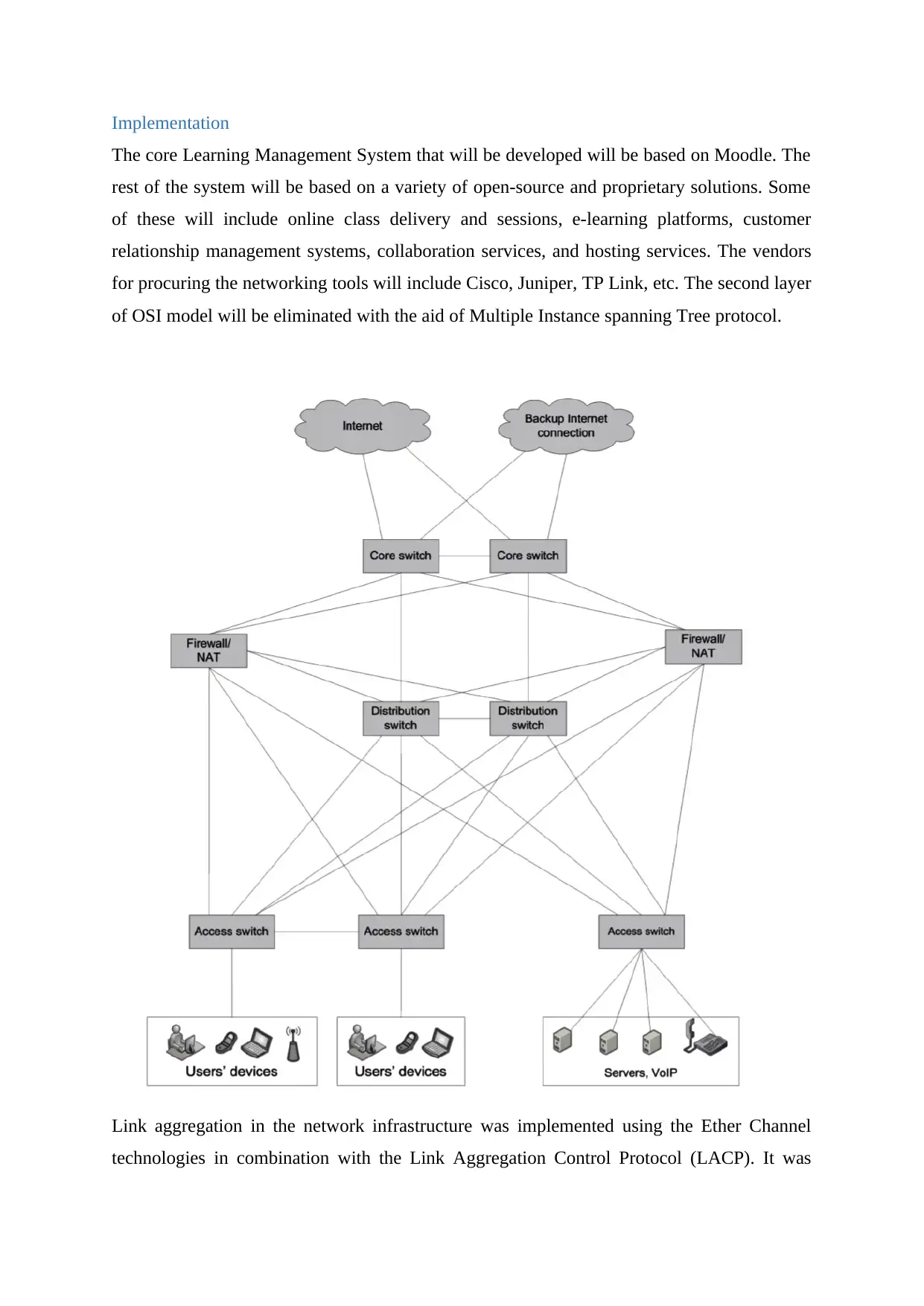
Implementation
The core Learning Management System that will be developed will be based on Moodle. The
rest of the system will be based on a variety of open-source and proprietary solutions. Some
of these will include online class delivery and sessions, e-learning platforms, customer
relationship management systems, collaboration services, and hosting services. The vendors
for procuring the networking tools will include Cisco, Juniper, TP Link, etc. The second layer
of OSI model will be eliminated with the aid of Multiple Instance spanning Tree protocol.
Link aggregation in the network infrastructure was implemented using the Ether Channel
technologies in combination with the Link Aggregation Control Protocol (LACP). It was
The core Learning Management System that will be developed will be based on Moodle. The
rest of the system will be based on a variety of open-source and proprietary solutions. Some
of these will include online class delivery and sessions, e-learning platforms, customer
relationship management systems, collaboration services, and hosting services. The vendors
for procuring the networking tools will include Cisco, Juniper, TP Link, etc. The second layer
of OSI model will be eliminated with the aid of Multiple Instance spanning Tree protocol.
Link aggregation in the network infrastructure was implemented using the Ether Channel
technologies in combination with the Link Aggregation Control Protocol (LACP). It was
Paraphrase This Document
Need a fresh take? Get an instant paraphrase of this document with our AI Paraphraser
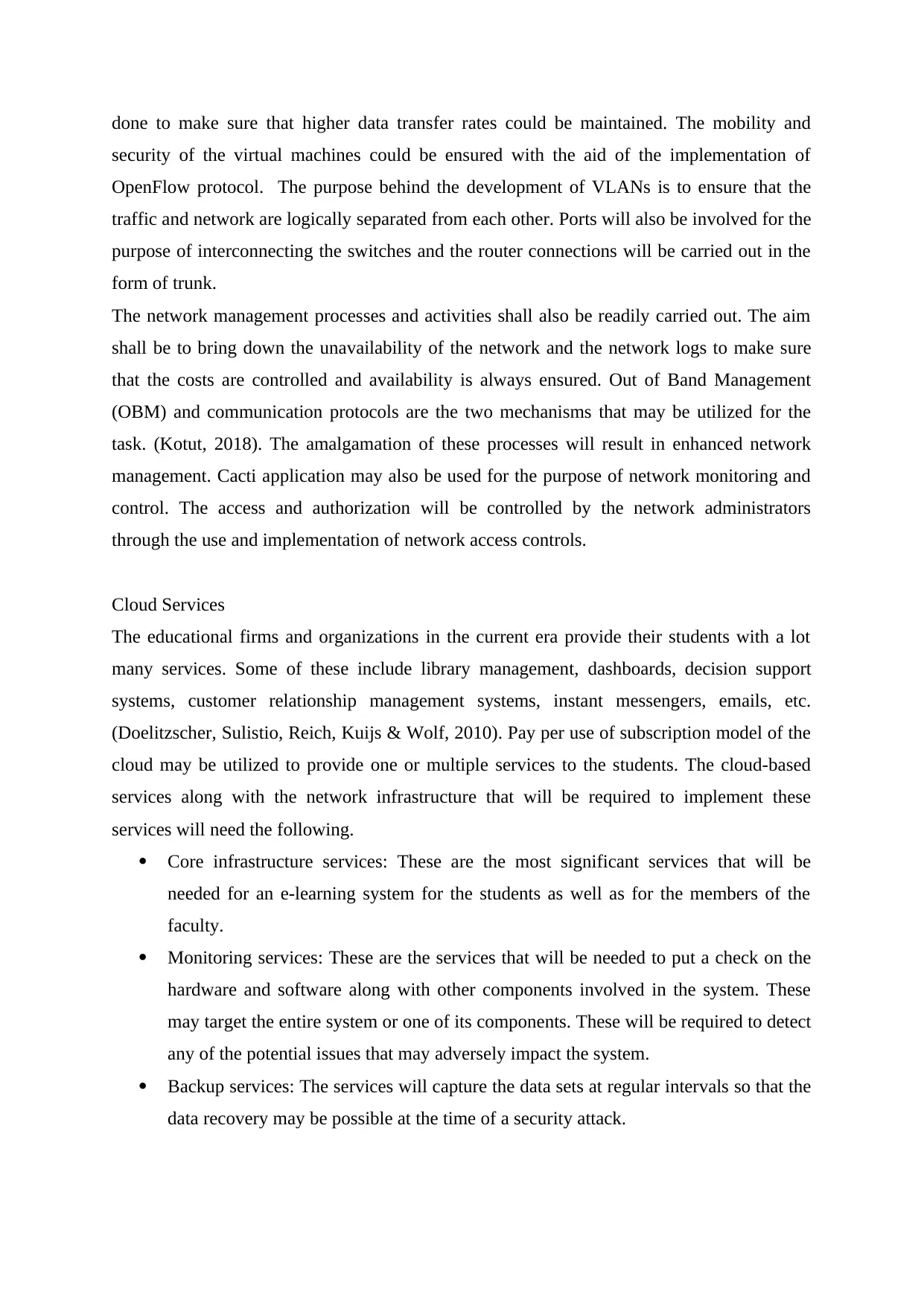
done to make sure that higher data transfer rates could be maintained. The mobility and
security of the virtual machines could be ensured with the aid of the implementation of
OpenFlow protocol. The purpose behind the development of VLANs is to ensure that the
traffic and network are logically separated from each other. Ports will also be involved for the
purpose of interconnecting the switches and the router connections will be carried out in the
form of trunk.
The network management processes and activities shall also be readily carried out. The aim
shall be to bring down the unavailability of the network and the network logs to make sure
that the costs are controlled and availability is always ensured. Out of Band Management
(OBM) and communication protocols are the two mechanisms that may be utilized for the
task. (Kotut, 2018). The amalgamation of these processes will result in enhanced network
management. Cacti application may also be used for the purpose of network monitoring and
control. The access and authorization will be controlled by the network administrators
through the use and implementation of network access controls.
Cloud Services
The educational firms and organizations in the current era provide their students with a lot
many services. Some of these include library management, dashboards, decision support
systems, customer relationship management systems, instant messengers, emails, etc.
(Doelitzscher, Sulistio, Reich, Kuijs & Wolf, 2010). Pay per use of subscription model of the
cloud may be utilized to provide one or multiple services to the students. The cloud-based
services along with the network infrastructure that will be required to implement these
services will need the following.
Core infrastructure services: These are the most significant services that will be
needed for an e-learning system for the students as well as for the members of the
faculty.
Monitoring services: These are the services that will be needed to put a check on the
hardware and software along with other components involved in the system. These
may target the entire system or one of its components. These will be required to detect
any of the potential issues that may adversely impact the system.
Backup services: The services will capture the data sets at regular intervals so that the
data recovery may be possible at the time of a security attack.
security of the virtual machines could be ensured with the aid of the implementation of
OpenFlow protocol. The purpose behind the development of VLANs is to ensure that the
traffic and network are logically separated from each other. Ports will also be involved for the
purpose of interconnecting the switches and the router connections will be carried out in the
form of trunk.
The network management processes and activities shall also be readily carried out. The aim
shall be to bring down the unavailability of the network and the network logs to make sure
that the costs are controlled and availability is always ensured. Out of Band Management
(OBM) and communication protocols are the two mechanisms that may be utilized for the
task. (Kotut, 2018). The amalgamation of these processes will result in enhanced network
management. Cacti application may also be used for the purpose of network monitoring and
control. The access and authorization will be controlled by the network administrators
through the use and implementation of network access controls.
Cloud Services
The educational firms and organizations in the current era provide their students with a lot
many services. Some of these include library management, dashboards, decision support
systems, customer relationship management systems, instant messengers, emails, etc.
(Doelitzscher, Sulistio, Reich, Kuijs & Wolf, 2010). Pay per use of subscription model of the
cloud may be utilized to provide one or multiple services to the students. The cloud-based
services along with the network infrastructure that will be required to implement these
services will need the following.
Core infrastructure services: These are the most significant services that will be
needed for an e-learning system for the students as well as for the members of the
faculty.
Monitoring services: These are the services that will be needed to put a check on the
hardware and software along with other components involved in the system. These
may target the entire system or one of its components. These will be required to detect
any of the potential issues that may adversely impact the system.
Backup services: The services will capture the data sets at regular intervals so that the
data recovery may be possible at the time of a security attack.
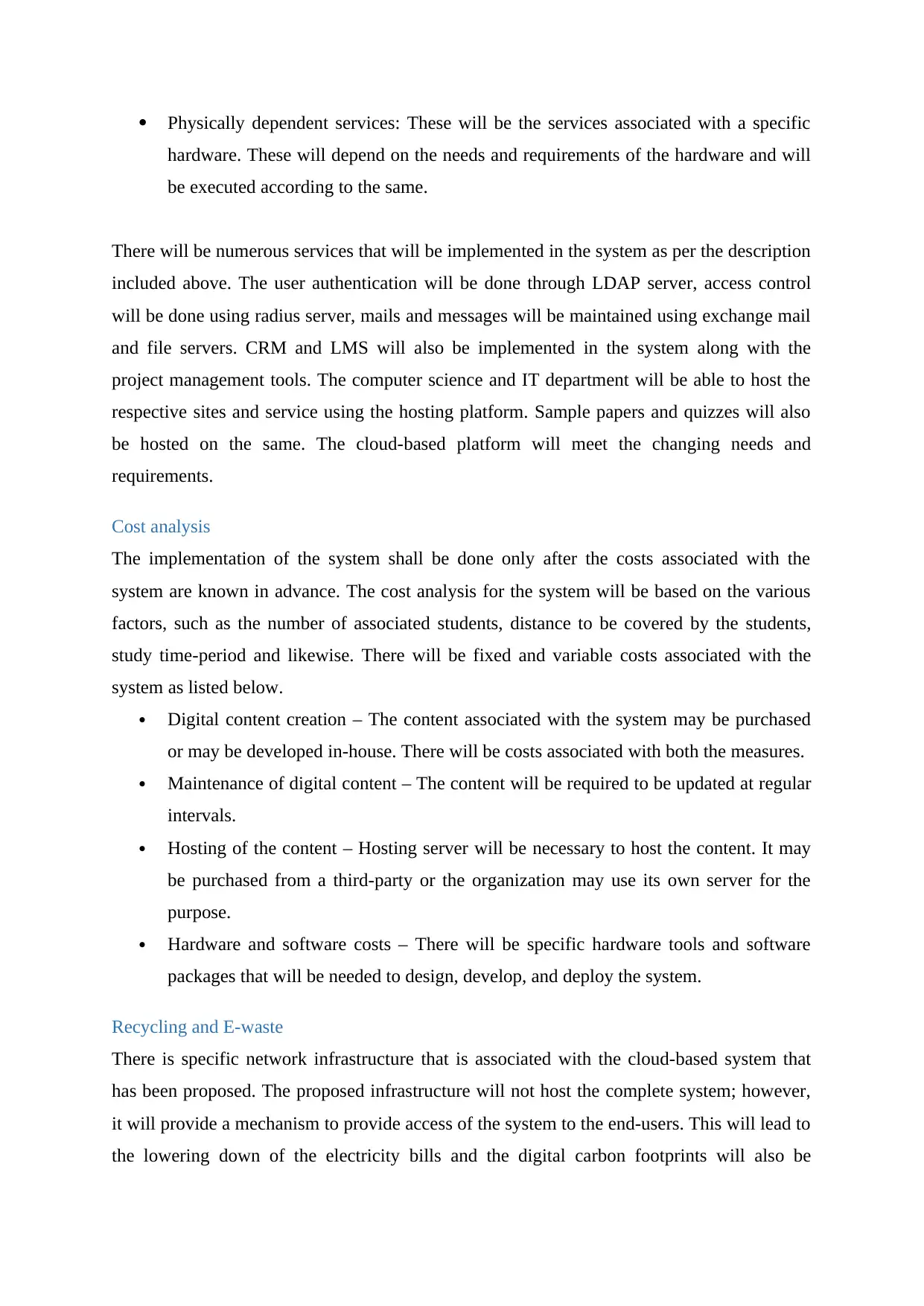
Physically dependent services: These will be the services associated with a specific
hardware. These will depend on the needs and requirements of the hardware and will
be executed according to the same.
There will be numerous services that will be implemented in the system as per the description
included above. The user authentication will be done through LDAP server, access control
will be done using radius server, mails and messages will be maintained using exchange mail
and file servers. CRM and LMS will also be implemented in the system along with the
project management tools. The computer science and IT department will be able to host the
respective sites and service using the hosting platform. Sample papers and quizzes will also
be hosted on the same. The cloud-based platform will meet the changing needs and
requirements.
Cost analysis
The implementation of the system shall be done only after the costs associated with the
system are known in advance. The cost analysis for the system will be based on the various
factors, such as the number of associated students, distance to be covered by the students,
study time-period and likewise. There will be fixed and variable costs associated with the
system as listed below.
Digital content creation – The content associated with the system may be purchased
or may be developed in-house. There will be costs associated with both the measures.
Maintenance of digital content – The content will be required to be updated at regular
intervals.
Hosting of the content – Hosting server will be necessary to host the content. It may
be purchased from a third-party or the organization may use its own server for the
purpose.
Hardware and software costs – There will be specific hardware tools and software
packages that will be needed to design, develop, and deploy the system.
Recycling and E-waste
There is specific network infrastructure that is associated with the cloud-based system that
has been proposed. The proposed infrastructure will not host the complete system; however,
it will provide a mechanism to provide access of the system to the end-users. This will lead to
the lowering down of the electricity bills and the digital carbon footprints will also be
hardware. These will depend on the needs and requirements of the hardware and will
be executed according to the same.
There will be numerous services that will be implemented in the system as per the description
included above. The user authentication will be done through LDAP server, access control
will be done using radius server, mails and messages will be maintained using exchange mail
and file servers. CRM and LMS will also be implemented in the system along with the
project management tools. The computer science and IT department will be able to host the
respective sites and service using the hosting platform. Sample papers and quizzes will also
be hosted on the same. The cloud-based platform will meet the changing needs and
requirements.
Cost analysis
The implementation of the system shall be done only after the costs associated with the
system are known in advance. The cost analysis for the system will be based on the various
factors, such as the number of associated students, distance to be covered by the students,
study time-period and likewise. There will be fixed and variable costs associated with the
system as listed below.
Digital content creation – The content associated with the system may be purchased
or may be developed in-house. There will be costs associated with both the measures.
Maintenance of digital content – The content will be required to be updated at regular
intervals.
Hosting of the content – Hosting server will be necessary to host the content. It may
be purchased from a third-party or the organization may use its own server for the
purpose.
Hardware and software costs – There will be specific hardware tools and software
packages that will be needed to design, develop, and deploy the system.
Recycling and E-waste
There is specific network infrastructure that is associated with the cloud-based system that
has been proposed. The proposed infrastructure will not host the complete system; however,
it will provide a mechanism to provide access of the system to the end-users. This will lead to
the lowering down of the electricity bills and the digital carbon footprints will also be
⊘ This is a preview!⊘
Do you want full access?
Subscribe today to unlock all pages.

Trusted by 1+ million students worldwide
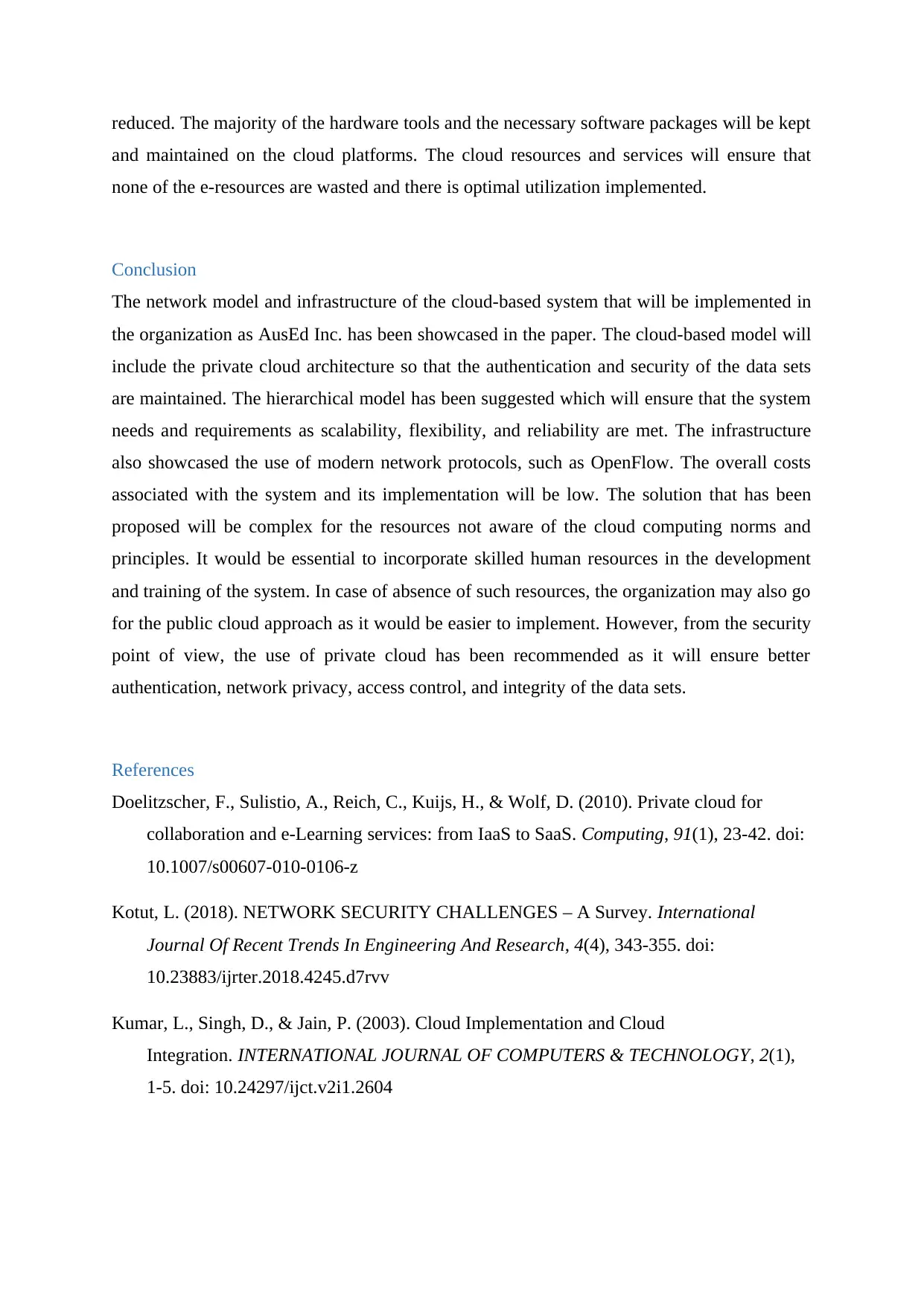
reduced. The majority of the hardware tools and the necessary software packages will be kept
and maintained on the cloud platforms. The cloud resources and services will ensure that
none of the e-resources are wasted and there is optimal utilization implemented.
Conclusion
The network model and infrastructure of the cloud-based system that will be implemented in
the organization as AusEd Inc. has been showcased in the paper. The cloud-based model will
include the private cloud architecture so that the authentication and security of the data sets
are maintained. The hierarchical model has been suggested which will ensure that the system
needs and requirements as scalability, flexibility, and reliability are met. The infrastructure
also showcased the use of modern network protocols, such as OpenFlow. The overall costs
associated with the system and its implementation will be low. The solution that has been
proposed will be complex for the resources not aware of the cloud computing norms and
principles. It would be essential to incorporate skilled human resources in the development
and training of the system. In case of absence of such resources, the organization may also go
for the public cloud approach as it would be easier to implement. However, from the security
point of view, the use of private cloud has been recommended as it will ensure better
authentication, network privacy, access control, and integrity of the data sets.
References
Doelitzscher, F., Sulistio, A., Reich, C., Kuijs, H., & Wolf, D. (2010). Private cloud for
collaboration and e-Learning services: from IaaS to SaaS. Computing, 91(1), 23-42. doi:
10.1007/s00607-010-0106-z
Kotut, L. (2018). NETWORK SECURITY CHALLENGES – A Survey. International
Journal Of Recent Trends In Engineering And Research, 4(4), 343-355. doi:
10.23883/ijrter.2018.4245.d7rvv
Kumar, L., Singh, D., & Jain, P. (2003). Cloud Implementation and Cloud
Integration. INTERNATIONAL JOURNAL OF COMPUTERS & TECHNOLOGY, 2(1),
1-5. doi: 10.24297/ijct.v2i1.2604
and maintained on the cloud platforms. The cloud resources and services will ensure that
none of the e-resources are wasted and there is optimal utilization implemented.
Conclusion
The network model and infrastructure of the cloud-based system that will be implemented in
the organization as AusEd Inc. has been showcased in the paper. The cloud-based model will
include the private cloud architecture so that the authentication and security of the data sets
are maintained. The hierarchical model has been suggested which will ensure that the system
needs and requirements as scalability, flexibility, and reliability are met. The infrastructure
also showcased the use of modern network protocols, such as OpenFlow. The overall costs
associated with the system and its implementation will be low. The solution that has been
proposed will be complex for the resources not aware of the cloud computing norms and
principles. It would be essential to incorporate skilled human resources in the development
and training of the system. In case of absence of such resources, the organization may also go
for the public cloud approach as it would be easier to implement. However, from the security
point of view, the use of private cloud has been recommended as it will ensure better
authentication, network privacy, access control, and integrity of the data sets.
References
Doelitzscher, F., Sulistio, A., Reich, C., Kuijs, H., & Wolf, D. (2010). Private cloud for
collaboration and e-Learning services: from IaaS to SaaS. Computing, 91(1), 23-42. doi:
10.1007/s00607-010-0106-z
Kotut, L. (2018). NETWORK SECURITY CHALLENGES – A Survey. International
Journal Of Recent Trends In Engineering And Research, 4(4), 343-355. doi:
10.23883/ijrter.2018.4245.d7rvv
Kumar, L., Singh, D., & Jain, P. (2003). Cloud Implementation and Cloud
Integration. INTERNATIONAL JOURNAL OF COMPUTERS & TECHNOLOGY, 2(1),
1-5. doi: 10.24297/ijct.v2i1.2604
Paraphrase This Document
Need a fresh take? Get an instant paraphrase of this document with our AI Paraphraser
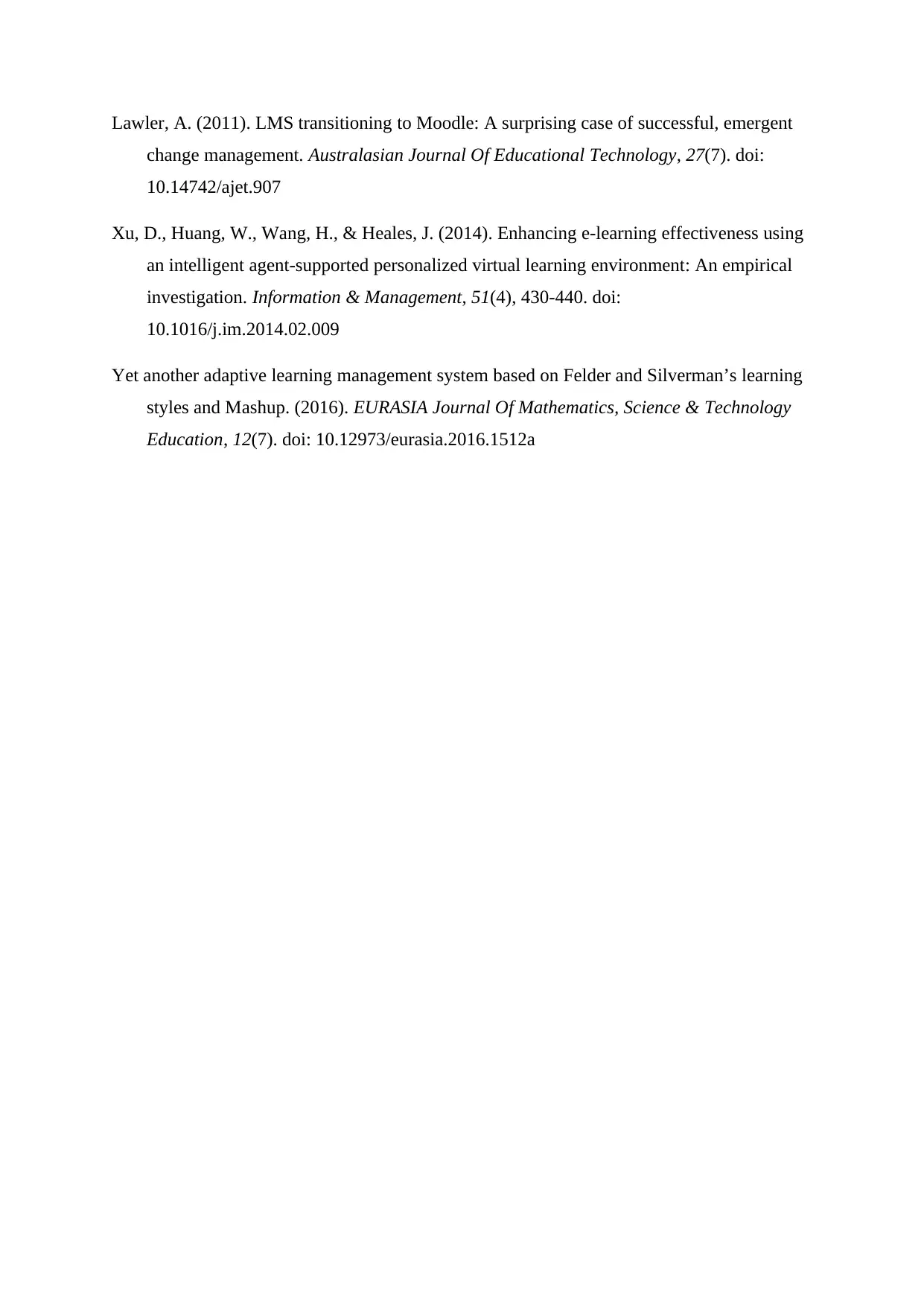
Lawler, A. (2011). LMS transitioning to Moodle: A surprising case of successful, emergent
change management. Australasian Journal Of Educational Technology, 27(7). doi:
10.14742/ajet.907
Xu, D., Huang, W., Wang, H., & Heales, J. (2014). Enhancing e-learning effectiveness using
an intelligent agent-supported personalized virtual learning environment: An empirical
investigation. Information & Management, 51(4), 430-440. doi:
10.1016/j.im.2014.02.009
Yet another adaptive learning management system based on Felder and Silverman’s learning
styles and Mashup. (2016). EURASIA Journal Of Mathematics, Science & Technology
Education, 12(7). doi: 10.12973/eurasia.2016.1512a
change management. Australasian Journal Of Educational Technology, 27(7). doi:
10.14742/ajet.907
Xu, D., Huang, W., Wang, H., & Heales, J. (2014). Enhancing e-learning effectiveness using
an intelligent agent-supported personalized virtual learning environment: An empirical
investigation. Information & Management, 51(4), 430-440. doi:
10.1016/j.im.2014.02.009
Yet another adaptive learning management system based on Felder and Silverman’s learning
styles and Mashup. (2016). EURASIA Journal Of Mathematics, Science & Technology
Education, 12(7). doi: 10.12973/eurasia.2016.1512a
1 out of 11
Related Documents
Your All-in-One AI-Powered Toolkit for Academic Success.
+13062052269
info@desklib.com
Available 24*7 on WhatsApp / Email
![[object Object]](/_next/static/media/star-bottom.7253800d.svg)
Unlock your academic potential
Copyright © 2020–2025 A2Z Services. All Rights Reserved. Developed and managed by ZUCOL.





